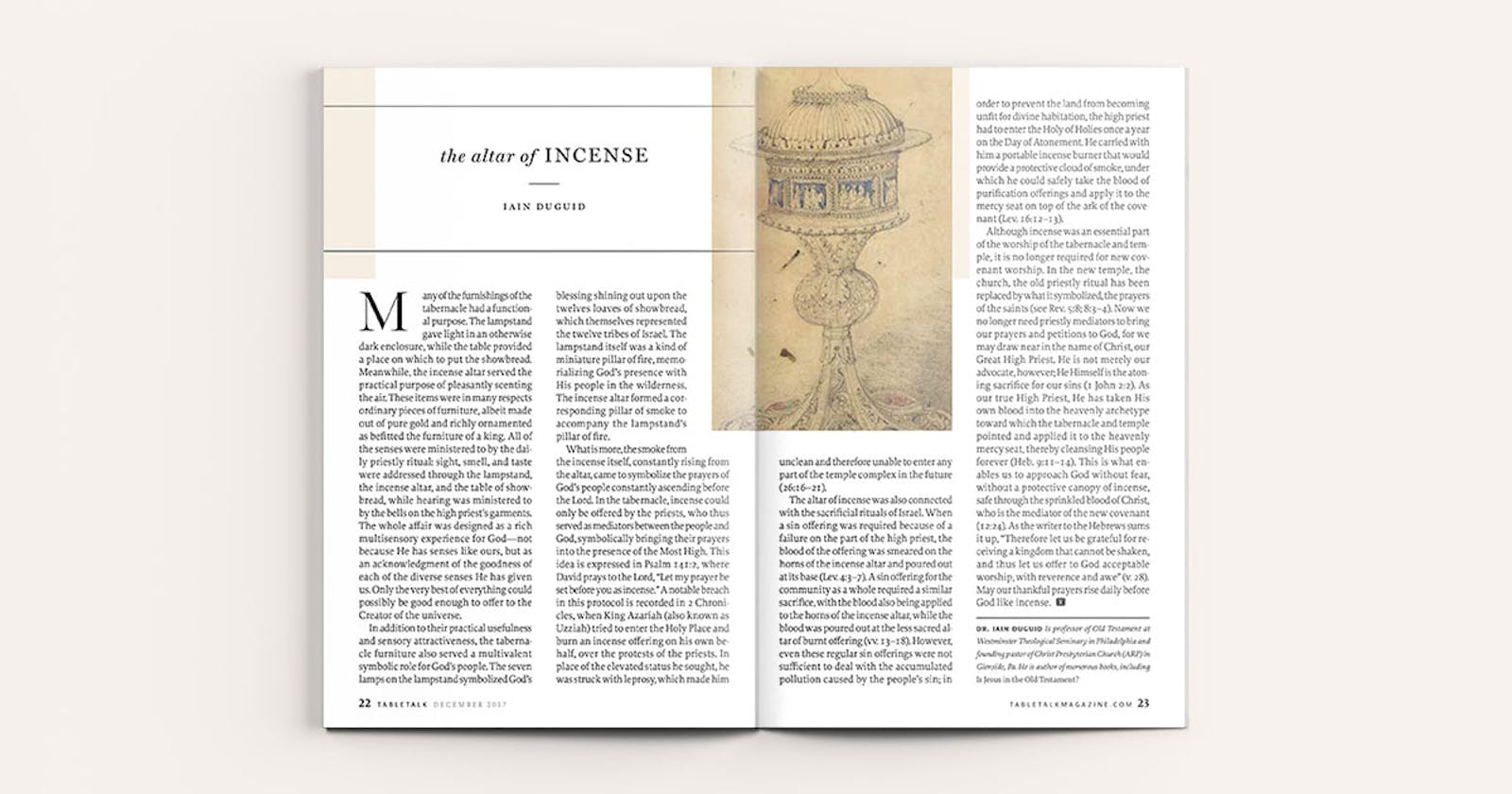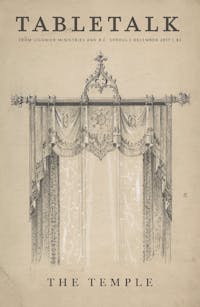
Request your free, three-month trial to Tabletalk magazine. You’ll receive the print issue monthly and gain immediate digital access to decades of archives. This trial is risk-free. No credit card required.
Try Tabletalk NowAlready receive Tabletalk magazine every month?
Verify your email address to gain unlimited access.
Many of the furnishings of the tabernacle had a functional purpose. The lampstand gave light in an otherwise dark enclosure, while the table provided a place on which to put the showbread. Meanwhile, the incense altar served the practical purpose of pleasantly scenting the air. These items were in many respects ordinary pieces of furniture, albeit made out of pure gold and richly ornamented as befitted the furniture of a king. All of the senses were ministered to by the daily priestly ritual: sight, smell, and taste were addressed through the lampstand, the incense altar, and the table of showbread, while hearing was ministered to by the bells on the high priest’s garments. The whole affair was designed as a rich multisensory experience for God—not because He has senses like ours, but as an acknowledgment of the goodness of each of the diverse senses He has given us. Only the very best of everything could possibly be good enough to offer to the Creator of the universe.
In addition to their practical usefulness and sensory attractiveness, the tabernacle furniture also served a multivalent symbolic role for God’s people. The seven lamps on the lampstand symbolized God’s blessing shining out upon the twelves loaves of showbread, which themselves represented the twelve tribes of Israel. The lampstand itself was a kind of miniature pillar of fire, memorializing God’s presence with His people in the wilderness. The incense altar formed a corresponding pillar of smoke to accompany the lampstand’s pillar of fire.
What is more, the smoke from the incense itself, constantly rising from the altar, came to symbolize the prayers of God’s people constantly ascending before the Lord. In the tabernacle, incense could only be offered by the priests, who thus served as mediators between the people and God, symbolically bringing their prayers into the presence of the Most High. This idea is expressed in Psalm 141:2, where David prays to the Lord, “Let my prayer be set before you as incense.” A notable breach in this protocol is recorded in 2 Chronicles, when King Azariah (also known as Uzziah) tried to enter the Holy Place and burn an incense offering on his own behalf, over the protests of the priests. In place of the elevated status he sought, he was struck with leprosy, which made him unclean and therefore unable to enter any part of the temple complex in the future (2 Chron. 26:16–21).
The altar of incense was also connected with the sacrificial rituals of Israel. When a sin offering was required because of a failure on the part of the high priest, the blood of the offering was smeared on the horns of the incense altar and poured out at its base (Lev. 4:3–7). A sin offering for the community as a whole required a similar sacrifice, with the blood also being applied to the horns of the incense altar, while the blood was poured out at the less sacred altar of burnt offering (vv. 13–18). However, even these regular sin offerings were not sufficient to deal with the accumulated pollution caused by the people’s sin; in order to prevent the land from becoming unfit for divine habitation, the high priest had to enter the Holy of Holies once a year on the Day of Atonement. He carried with him a portable incense burner that would provide a protective cloud of smoke, under which he could safely take the blood of purification offerings and apply it to the mercy seat on top of the ark of the covenant (Lev. 16:12–13).

Although incense was an essential part of the worship of the tabernacle and temple, it is no longer required for new covenant worship. In the new temple, the church, the old priestly ritual has been replaced by what it symbolized, the prayers of the saints (see Rev. 5:8; 8:3–4). Now we no longer need priestly mediators to bring our prayers and petitions to God, for we may draw near in the name of Christ, our Great High Priest. He is not merely our advocate, however; He Himself is the atoning sacrifice for our sins (1 John 2:2). As our true High Priest, He has taken His own blood into the heavenly archetype toward which the tabernacle and temple pointed and applied it to the heavenly mercy seat, thereby cleansing His people forever (Heb. 9:11–14). This is what enables us to approach God without fear, without a protective canopy of incense, safe through the sprinkled blood of Christ, who is the mediator of the new covenant (Heb. 12:24). As the writer to the Hebrews sums it up, “Therefore let us be grateful for receiving a kingdom that cannot be shaken, and thus let us offer to God acceptable worship, with reverence and awe” (v. 28). May our thankful prayers rise daily before God like incense.
